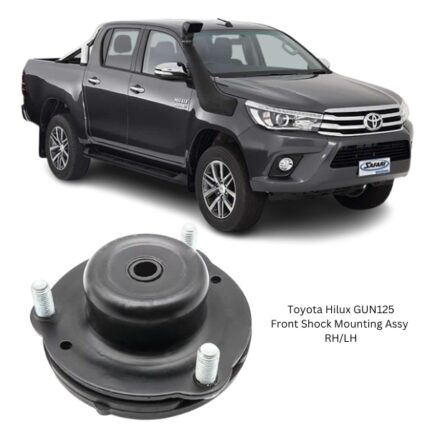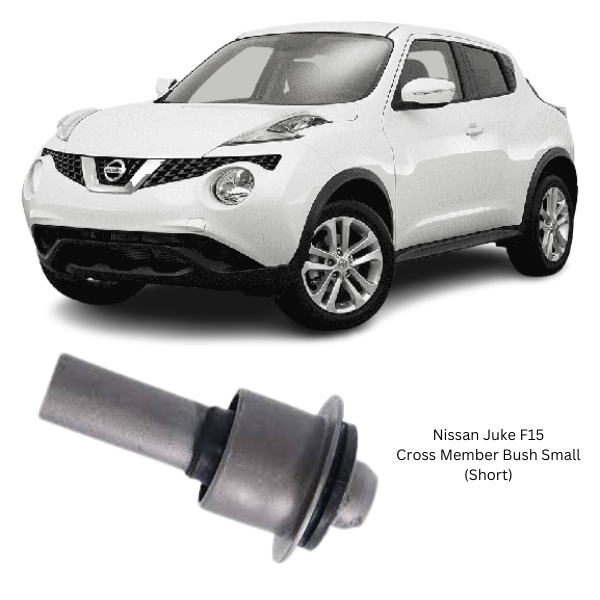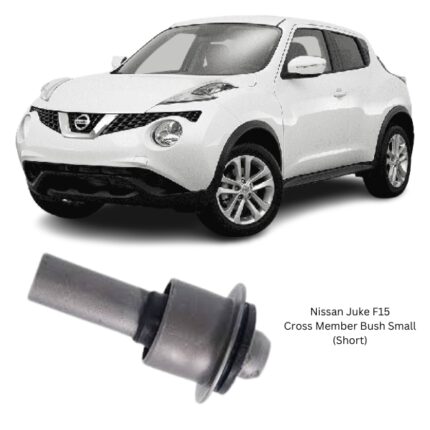Get Nissan Juke F15 Cross Member Bush Small (Short) 54467-JD00A in Kenya
The Cross Member Bush Small (Short) is a compact yet essential suspension component designed to provide isolation, stability, and strength at the junction between the vehicle’s cross member and chassis or subframe. While often overlooked, this bushing plays a critical role in maintaining the integrity of the suspension geometry, absorbing vibrations and loads, and minimizing the transmission of road harshness and noise into the vehicle cabin.
This particular version — a “small” or “short” cross member bush — is commonly found in vehicles where the cross member or subframe requires multiple bushings of varying sizes to accommodate complex mounting geometries. Its precise dimensions and material composition are tailored for use in specific applications where space is constrained but performance cannot be compromised.
Purpose and Function
The Cross Member Bush (Short) is primarily responsible for:
-
Vibration Isolation
It dampens vibrations and harshness transferred from the suspension and drivetrain to the body of the vehicle. This results in a smoother, quieter ride. -
Load Absorption
It helps absorb and distribute forces generated by acceleration, braking, and cornering. This protects the chassis from stress fractures and fatigue. -
Noise Reduction
It serves as a buffer between metal components, preventing direct contact and reducing noise transmission. -
Alignment Maintenance
By maintaining consistent spacing and positioning of the cross member, the bushing helps preserve correct alignment of suspension and drivetrain components. -
Structural Support
It acts as a stabilizer by helping keep the cross member fixed while still allowing necessary flex and movement due to road conditions.
Design and Construction
Though small in size, the Cross Member Bush Small (Short) is engineered for durability and performance. Its basic structure includes:
1. Outer Shell
-
Made from high-grade steel or aluminum.
-
Provides structural strength and forms the press-fit outer surface that secures the bush into the cross member or chassis.
-
Often corrosion-resistant due to a coating of zinc or powder paint.
2. Rubber or Elastomer Core
-
The heart of the bushing, typically composed of natural or synthetic rubber compounds.
-
Responsible for the absorption of vibrations and torsional forces.
-
Tuned for the ideal balance between flexibility and rigidity.
3. Inner Sleeve or Tube
-
A metal or hardened plastic sleeve that supports the mounting bolt or shaft.
-
Ensures alignment and prevents deformation of the bushing under load.
-
Allows rotation or limited pivoting of the cross member relative to the chassis.
4. Bonded vs. Floating Construction
-
In bonded designs, the rubber is vulcanized to both inner and outer sleeves for stability.
-
Floating designs allow more movement, suitable for specific dynamic applications.
Material Characteristics
Each component of the bushing is made to withstand a range of mechanical and environmental stresses:
-
Rubber
Specially formulated for durability and elasticity, rubber bushings offer excellent shock absorption, though they may wear or crack over time. -
Polyurethane (Aftermarket Option)
Provides increased firmness and longevity compared to rubber. Preferred in performance or off-road applications where precise handling is prioritized over comfort. -
Metal Inserts
Treated to resist rust, corrosion, and fatigue. Structural integrity is essential for holding up under the vehicle’s weight and dynamic stress.
Symptoms of a Worn Cross Member Bush
As with many suspension components, a failing cross member bush can have a wide range of consequences, affecting comfort, safety, and mechanical performance. Signs of failure include:
-
Clunking or Knocking Sounds
Occur when the bushing has excessive play or has degraded completely, allowing metal-to-metal contact. -
Vibration or Harshness in the Cabin
Without proper damping, road vibrations become more pronounced and may be felt through the floor or steering. -
Loose or Wandering Steering
Bushing deterioration can lead to poor alignment of suspension geometry, affecting steering precision. -
Uneven Tire Wear
Misalignment due to failing bushes may cause rapid or uneven tread wear. -
Poor Braking Stability
As the cross member shifts slightly under load, braking force distribution may become inconsistent, especially under emergency stops. -
Visual Signs
Cracks in the rubber, separation from the metal shell, or complete collapse are visible indicators of failure.
Installation and Replacement Considerations
Replacing a Cross Member Bush Small (Short) may seem simple, but it often requires precision and care:
-
Vehicle Supported on Stands or Lift
Proper lifting is crucial to access the cross member without compromising safety. -
Removal of the Cross Member or Subframe
Depending on design, the cross member may need to be detached entirely to access the bush. -
Pressing Out the Old Bush
A hydraulic press or bushing removal tool is typically required. Improper tools can damage surrounding components. -
Cleaning and Inspecting the Mounting Surface
Any rust or debris in the mounting area should be cleaned before installation. -
Pressing in the New Bush
The new bushing must be installed in the correct orientation to function effectively. It must seat fully without distorting the rubber. -
Torque Specifications
All bolts and nuts should be tightened to manufacturer-recommended torque values to ensure optimal performance. -
Wheel Alignment
It’s advisable to perform a wheel alignment after replacing suspension bushings to restore correct geometry.
Application and Compatibility
The Cross Member Bush Small (Short) is often used in conjunction with other bushings of varying sizes on the same cross member or subframe. These may be specific to certain models or trims of a vehicle and vary by position (e.g., front vs rear, inner vs outer).
Always ensure:
-
The correct bushing size and orientation.
-
That the bushing matches the OEM specifications.
-
RH/LH side is respected where applicable.
Performance Benefits of Timely Replacement
By replacing a worn Cross Member Bush Small (Short), you can expect the following advantages:
-
Quieter Ride: Reduced clunking and structural noise.
-
Smoother Handling: Maintains suspension geometry and responsiveness.
-
Improved Braking: Enhanced stability under deceleration.
-
Longevity of Other Components: Reduces strain on other bushings, mounts, and suspension parts.
-
Driver Confidence: A more planted and composed driving experience.
Follow us on Facebook for more parts.





Reviews
Clear filtersThere are no reviews yet.